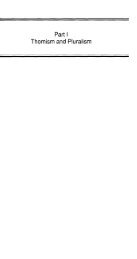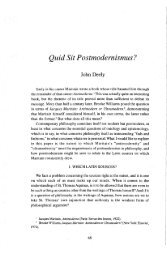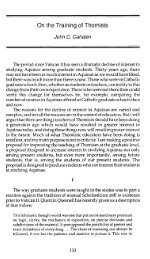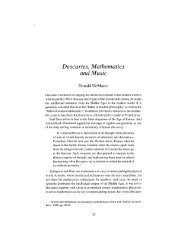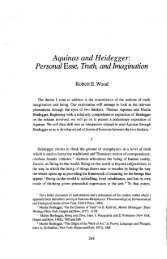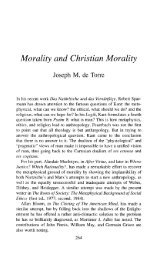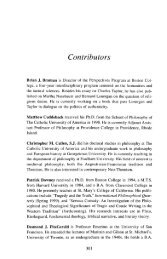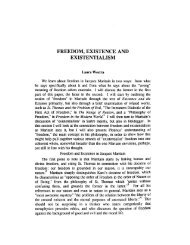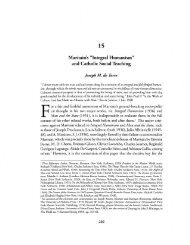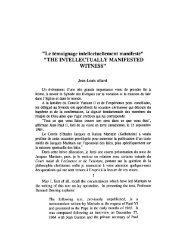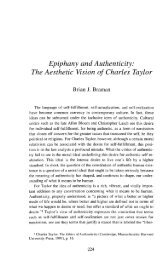Desmond J. FitzGerald - Jacques Maritain Center
Desmond J. FitzGerald - Jacques Maritain Center
Desmond J. FitzGerald - Jacques Maritain Center
Create successful ePaper yourself
Turn your PDF publications into a flip-book with our unique Google optimized e-Paper software.
Gilson, Aeterni Patris and theDirection of Twenty-First CenturyCatholic Philosophy<strong>Desmond</strong> J. <strong>FitzGerald</strong>There have been moments since Vatican II when some of us teacherswith a Thomistic background have wondered if the Thornisrn of ouryouth could carry beyond our century.Those of my generation recall the enthusiasm we devoted to thestudy of St. Thomas Aquinas in those years of World War II and in thedecades afterwards; we remember how eagerly we sought each newbook by the interpreters of Thomas: <strong>Maritain</strong>, Gilson, Pegis, Bourke,Owens, Maurer, Klubertanz, Henle, and hastened to pass on theirinsights to our students. But today we are concerned that we have failedto ignite the generation of our students with the fire we caught from ourteachers. Yes, there are exceptions and the graduate schools of theCatholic University of America, Marquette, St. Louis, Toronto andNotre Dame will point proudly to those exceptions in their letters ofreconunenda tion. 1As Joseph Owens noted in 1979 at the University of St. Thomas'scelebration of the centenary of Leo XIII' s Aeterni Patris: ''The centenaryoccurs unfortunately at a low ebb in general Thomistic interest. For themost part, teachers and writers in philosophy at the moment do notseem to like Aquinas, and students are not being attracted to hirn." 2And yet as Owens goes on to irnpl y, this rna y be thebes t time to focuson our need to reflect on the place of St. Thomas as our metaphysicalteacher.There are a number of events that give hope that we are passing outof a phase where enthusiasm was declining and entering a new phasewhere more students are being turned toward Aquinas and meetinghim as if they were his discoverers. The translation and publication of1. Cf. James Collins, "Thomism in the College," in Three Paths in Philosophy(Chicago: Henry Regnery, 1962) for a discussion of the transition Catholic universitiesand colleges were going through at the beginning of Vatican II in 1962.2. Owens, "The Future of Thomistic Metaphysics," in One Hundred Years ofThomism, Aeterni Patris and Afterwards: A Symposium, ed. Victor B. Brezik (Houston,Texas: <strong>Center</strong> for Thomistic Studies, University of St. Thomas, 1981 ), p. 146.83
84 • DESMOND J. FITZGERALDthe Catholic University of Lublin textbooks led by my colleague, Fr.Andrew Woznicki, and Fr. Francis Lescoe;-3 the founding just over adozen years ago of this <strong>Maritain</strong> Association and its significant conferencesand publications, and the meeting here this week on the "Futureof Thomism."Now our meeting in a special way has Fr. Gerald McCool's FromUnity to Pluralism: The Internal Evolution ofThomism as its focal point. Ashas been noted, Fr. McCool's study is the continuation of his 1977Nineteenth Century Scholasticism: The Search for a Unitary Method (originallyCatholic Theology in the Nineteenth Century).Fr. McCool first studied the revival of so-called Scholastic theologyin the 1800s in which the persons of Liberatore and Kleutgen wereamong the leaders culminating in the encyclical Aeterni Patris of Leo IIIin 1879. 5 Now his present volume has analyzed how in our twentiethcentury the unity anticipated by the directives of Leo XIII has evolvedinto the plurality of Thomisms of today.Fr. McCool's thesis is that the expectations of Aeterni Patris thatThomistic philosophy would serve the progress of theology in thetwentieth century have not been realized. The unity that was anticipatedhas not been achieved and now at the end of this century we aredisappointed.As Fr. McCool says: "Or, to put it in more forceful terms, the hopethat had animated Aeterni Patris at the very beginning of the neo-Scholasticmovement had no real support in the philosophy of St. Thomashimself ." 6If one were to pick landmarks to identify changes in the roadway,Vatican II through the early 1960sstands there as a recognizable marker.This pastoral council in its return to Scripture for its inspiration seemed3. See Mieczylaw A. Krapiec, I-Man: An Outline of Philosophical Anthropology, trans.Marie Lescoe, Andrew Woznicki, Theresa Sandok eta!. (New Britain, Connecticut:Marie! Publications, 1983). An abridged version by Francis Lescoe and RogerDuncan was published in 1985.4. From Unity to Pluralism: The Internal Evolution ofThomism (New York: FordhamUniversity Press, 1989); Nineteenth-Century Scholasticism: The Search for a UnitaryMethod (New York: Fordham University Press, 1989). During the discussion Fr.McCool mentioned he was putting together a text on "TheN eo-Thomist Movement"for the Outstanding Christian Thinkers series, Chapman Press.5. The text of Aeterni Patris is available in One Hundred Years ofThomism; the EtienneGilson-edited The Church Speaks to the Modern World: The Social Teachings of Leo XII(Garden City, New York: Doubleday Image Book, 1954); as an appendix in <strong>Jacques</strong><strong>Maritain</strong>, St. Thomas Aquinas (New York: Meridian Books, 1958); and of coursecollections of the encyclicals of Leo XIII.6. From Unity to Pluralism, pp. 228-29.
DIRECI'ION OF CATHOLIC PHILOSOPHY • 87further, the emphasis that Gilson gave to these Thomistic principles cancontinue to serve theology.Any one of us could compose a list of features of Gilson's writingswhich would characterize his philosophy. For my purpose I havechosen only a few: the affirmation of Christian philosophy, the underliningof esse, the act of being in Thomistic metaphysics, the realism of hisepistemology, and as a special feature, his representation of St. Thomas'sphilosophy of the human person. These are solid achievements whichthe theologian can use in the work of faith seeking understanding.With so much written on Christian philosophy it hardly needs to bereexplained here. 12 As has been noted, one establishes its possibilityfrom the fact that it does exist. Without returning to the often quoted textof Exodus (3: 14) calling attention to the fact that when asked his nameGod replied in terms of existence: I AM WHO I AM, the very fact that inthe light of revelation St. Augustine and St. Thomas looked at this worldof experience as a "created world" rather than one which had alwaysexisted, meant that they were looking at something that happened to berather than had to be. Thus they could be legitimate philosophers whoexperienced the world differently than did Plato and Aristotle in virtueof their faith. They were experiencing the world as philosophers do butthey were alerted to experience a contingent world, one in which thethings in it had been given existence. Thus there was this sensitivity toesse in Christian thinkers which distinguished them from their Greekpredecessors.Another area in which it seems clear that Gilson as a twentiethcenturyThomist is closest to his master is epistemology. 13 Where otherstudents of St. Thomas sought to modemize Aquinas after the fashionsof Descartes and Kant, Gilson rejected this and returned to the directrealism of his master.12. One can begin with Christianity and Philosophy, trans. Ralph MacDonald (NewYork: Sheed and Ward, 1939) [Christianisme et Philosophic (Paris: J. Vrin, 1936)]; andthen go on to the "Introduction" in The Christian Philosophy of St. Thomas Aquinas, L.K. Shook's translation of Le thomisme: Introduction a Ia philosophie de Saint Thomasd'Aquin, 5th ed. (Paris, 1949); and "Revelation and the Christian Teacher," Part 1 ofElements of Christian Philosophy (Garden City, New York: Doubleday, 1960). Shookis completing his translation of Le thomisme, 6th ed. (1955), and its publication willbe through the Pontifical Institute of Mediaeval Studies, Toronto.13. The classic source is Realisme thomist et critique de Ia connaissance (Paris: J. Vrin,1936) and Le rialisme methodique (Paris: Pierre Tequi, 1936). There is a translation ofthe first by Mark A. Wauck, Thomist Realism and Critique of Knowledge (San Francisco:Ignatius Press, 1586), and the second, Methodical Realism, has been translated byPhilip Trower and is available from Christendom Press, Front Royal, Virginia, 1990.
88 • DESMOND J. FITZGERALDFor Gilson human knowing begins with the recognition that somethingis. As he affirmed in his autobiographical The Philosopher andTheology, he was preoccupied with thingsY· This affirmation of a directrealism is not a naive realism. One who has an intimate knowledge of therange of philosophy, modem as well as medieval thought, cannot beregarded as naive with respect to the problems of knowledge. But adirect realism is one wherein the knower grasps the intelligibility of thething known through one's human knowledge which is a simultaneoussensio-intellectual experience. What Gilson challenged so much in hisepistemological writings of the 1930s were the various attempts by socalledneo-Thomists to dress Aquinas in the fashions of Descartes andKant. These controversies of over sixty years ago are largely forgotten;the articles and books exist, of course, but they are intriguing only to thehistorian of the revival of Thomism in our century. Our students aresurely not concerned about them. To read about the controversies servesas a reminder of the vitality and concern of the Scholastics before WorldWar II, and I find a nostalgia for the time when our intramural disputeswere taken so serious! y. Fr. McCool is excellent in his review of Gilson'saccomplishments in this and other areas such as the controversy over"Christian philosophy." But in the final paragraph of his assessment ofGilson, there is an ambivalence. For all the credit he gives Gilson forclarifying the meaning of an authentic Thomism, he does not followthrough and nominate Gilson as the model or guide for the nextcentury's philosophic support for theology.As Gilson himself observed, if his criteria for determiningThomism are theright ones, there can still be Thomists but there can be no Neo-Thomists.For the authentic disciple of the Angelic Doctor progress can consist onlyin his ever-deepening understanding of what St. Thomas himself haswritten. Progress for the Thomist cannot consist in devising new anddifferent philosophies and claiming St. Thomas' support for positionswhich were never his own. 15In a very special way Gilson's philosophy of man or philosophicalanthropology serves to present to our times and to the next century anunderstanding of the human person which is one part of the foundationof theology. Another way of saying this is to affirm that a soundunderstanding of the human person is fundamental to the investigationof man's relation to God.14. Gilson, The Philosopher and Theology, trans. Cecile Gilson (New York: RandomHouse, 1%2), p. 18.15. From Unity to Pluralism, p. 197.
DIRECTION OF CATHOLIC PHILOSOPHY • 89Dr. Anton Pegis, one of Gilson's early students in North America,never tired in his writings of returning again and again to the theme oftheunityofrnaninAquinas. 16 0f course this unity was a composite unityof matter and form, but as Pegis pointed out again and again, in St.Thomas's theory of man, you had that unique level of the hierarchy ofbeing wherein a subsistent form, man's soul, is also the form of a body.In one stroke St. Thomas had resolved what was Descartes's greateststumbling block: how to defend personal immortality and at the sa metime to affirm the unity of man.In Gilson's Christian Philosophy of St. Thomas Aquinas, and in the latertextbook written for undergraduates Elements of Christian PhilosophyPthis specialfeature of Aquinas is made central: the human soul endowedwith esse, a subsistent form, comes to be as the life of a particular body,an individual quantity of rna tter, conferring on the body the act of livingand making with it a living human person.Paraphrase cannot begin to do justice to the magisterial way Gilsonpresents the philosophy of Aquinas in Elements of Christian Philosophy. Itbegs for quotation. Yet such is the presentation that one would betempted to quote not paragraphs buy whole chapters. Suffice it to saythat this work written late in his career is both a metaphysical textbookand a historical treatise blended in an extraordinary way. Gilson hadalways been a historian of philosophy but there emerged out of hisepistemological controversies of the thirties, a confident teacher totallyimmersed in his subject the doctrine of St. Thomas and able topresent it in a dynamic, exciting way. 18The discussion of the problem of the demonstration of personalimmortality may be taken as an example. Here Gilson shows howAquinas could start with Aristotle's theory of man as a composite ofbody and soul, but in virtue of recognizing that the human soul has anesse, an act of being, go far beyond Aristotle's theory. This makes the soula subsistent entity as well as the form of the body. Gilson goes on to showhow neither Scotus nor Cajetan realized this point in their failure toappreciate the originality of Aquinas in his transformation of Aristotelianprinciples. Thus Gilson's chapter on ''The Human Soul" is not just16. Cf. "The Notion of Man in the Context of Renewal" in vol. 1, Theology ofRenewal, Renewal of Religious Thought, ed. Laurence K. Shook (Montreal: PalmPublishers, 1968); and "Some Reflections on Summa Contra Gentiles II, 56" in AnEtienne Gilson Tribute, ed. Charles J. O'Neil (Milwaukee, Wisconsin: MarquetteUniversity Press, 1959).17. Elements of Christian Philosophy.18. Cf. <strong>Desmond</strong> J. <strong>FitzGerald</strong>, "Etienne Gilson: From Historian to Philosopher,"in Thomistic Papers, II, ed.l..eonard A. Kennedy and Jack C. Marler (Houston, Texas:<strong>Center</strong> for Thomistic Studies, University of St. Thomas, 1986).
90 • DESMOND J. FITZGERALDan exposition of what Aquinas taught but it is, further, a livelyof the sixteenth-century debates in which Pietro Pomponazzi andmas de Vio, Cardinal Cajetan, were such central characters. 19Without going into the details of these chapters, the treatment"Man and Knowledge" and "Man and Will" are written in thethe master teacher and so make for Aquinas's philosophy ofand choice an exposition comparable to the discussion of theity of the human soul.In "N eo-Thomism and the Tradition of St. Thomas ," 20 Gerald McCoolreviews the revival Thomism in our century, and notes the falling off ofattention to "the tradition of St. Thomas" in our present time. McCooltreats of Gilson's role in this revival especially clarifying the differencesbetween Aquinas and various later Scholastics such as Suarez, Cajetan,and John of St. Thomas. McCool always treats Gilson with great respectand does an excellent job of presenting the features of Gilson's contribu- .tions to contemporary Thomism. But when all is said and done, in hisconclusion he ends up favoring Karl Rahner and Bernard Lonergan asthe best hope of neo-Thomistic philosophy serving theology into thetwenty-first century.Since I cannot make a claim to any special knowledge of Rahner orLonergan, I cannot dispute his preference. Buti am puzzled at his failureto include Gilson's Thomism. Having granted that Gilson probablycomes closest to an "authentic Thomism" in his grasp of St. Thomas'sactual teaching, I fail to appreciate why he is not on the final list.As Leo XIII says toward the close of Aeterni Patris:Let carefully selected teachers endeavor to implant the doctrine of ThomasAquinas in the minds of students, and set forth clearly his solidity andexcellence over others. 21According tom y understanding of the expectations of Aeterni Patris,Gilson, as well as <strong>Maritain</strong>, should be among those "carefully selectedteachers" we can use as theology moves into the twenty-first century.19. The graduate students of Paul Osker Kristeller, Professor Emeritus, ColumbiaUniversity, have explored this controversy in a number of doctoral studies. Cf.Martin Pine, Pietro Pomponazzi: Radical Philosopher of the Renaissance (Padua: EditriceAntenore, 1986).20.Thought 62 (June 1987).21.Church Speaks to the Modern World, p. 50.



